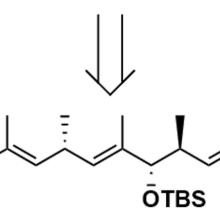Natural Products
Natural Products are produced by every living organism and are therefore ubiquitous in life. Each one has its own purpose, from structure-giving building blocks and metabolic intermediates to signaling and protection systems. Although their original purpose is not necessarily known, many of them show biological and pharmacological activity in the human body. For centuries, pain-relieving or soothing plant extracts were used to treat various ailments.[1] Modern methods such as liquid chromatography (LC) and nuclear magnetic resonance spectroscopy (NMR) allow the isolation and characterization of new complex natural products. With known structure, the synthesis of such natural products can be realized. We focus on the total synthesis of biologically active natural products and novel methods of building specific structural motifs.
[1] D. Martin, J. Für Prakt. ChemieChemiker-Ztg. 1998, 340, 585–585.
Anti-Malaria Natural Products [Benedikt Kolb, Marcel Freund, Daniela Silva dos Santos, Burcu Sönmez]
Malaria is the foremost tropical illness, responsible for about 435.000 deaths each year. The disease is caused by parasites of the Plasmodium species that are transmitted to humans via mosquito stings. Today, malaria can be treated with several natural-product based medications such as chloroquine and artemisinin. However, drug resistances in Plasmodia have been increasing for many years. Additionally, due to climate change the transmitting mosquitos become endemic to moderate climate zones. To treat malaria infections, it is therefore important to get access to new active compounds.[2,3]
Our goal is to develop reliable synthetic routes to various anti plasmodial natural products for biological testing.
-
[2] World Health Organization, World Malaria Report 2014, World Health Organization, Genève.
[3] Link (nobelprize) (30.11.2020); Link (Wikipedia) (30.11.2020); CDC, Center of Disease Control, US-Behörde (30.11.2020).
Polycyclic Natural Products [Jan Grammel, Burcu Sönmez]
Polycyclic natural products such as spinosyn or clifednamide display promising biological activities and their intriguing structures provide challenging synthetic projects. Hence, we investigate the use of tetrahydroindanones[4] in the efficient synthesis of polycyclic scaffolds via the Diels-Alder reaction. Further projects include the step-economic total synthesis of polycyclic natural products and chiral boron reagents in organic chemistry. To perform these challenging syntheses, Schlenk technique, column chromatography as well as HPLC are employed and compound analysis is achieved mainly by (hetero nuclear) NMR, supported by MS and X-ray diffraction and computation.
[4] Y. Stöckl, W. Frey, J. Lang, B. Claasen, A. Baro, S. Laschat, Synthesis 2019, 51, 1123–1134.
Antibiotic Natural Products [Andreas Greulich]
Rising antibiotic resistance is a threat to everyone, leading to hard or non-treatable bacterial infections that cause higher medical costs and a rise in mortality.[5] For new treatments, the approach via host-pathogen-interactions is promising. During a bacterial infection, host cells withdraw essential nutrients, e.g. Fe3+/2+, to protect themselves. To overcome, this lack of iron, bacteria produce iron binding natural products, such as aerobactin, enterobactin and staphyloferrin A, so called siderophores.[6,7] Inspired by these siderophores, our group aims to synthesize iron binding natural products and their derivatives. Due to the iron complexation, these molecules should show antibiotic effects.
[5] Link (WHO) (30.11.2020).
[6] U. Bilitewski, J. A. V. Blodgett, A.-K. Duhme‐Klair, S. Dallavalle, S. Laschat, A. Routledge, R. Schobert, Angew. Chem. 2017, 129, 14552–14575.
[7] M. Miethke, M. A. Marahiel, Microbiol. Mol. Biol. Rev. 2007, 71, 413–451.
BH3-mimetics [Bianca Wank]
Inhibitors (BH3-mimetics) for anti-apoptotic BCL-2 family members are a cutting-edge research topic in cancer treatment, with Venetoclax being the first clinically used example of this class of drugs.[1,2] These anti-apoptotic proteins are often over expressed in cancer cells. When they are inhibited, the inherent ability of the cells to self-regulate their live span gets reactivated – apoptotic cell death occurs. In this context, the discovery and synthetic design of related molecules with the desired inhibition properties as well as understanding the mechanistic process in the cells are of interest.[3,4]
[1] N. Catron, S. Chen, Y. Gong, G. G. Zhang, Salts and Crystalline Forms of an Apoptosis-Inducing Agent, 2014, US8722657B2.
[2] European Medicines Agency, 2021, Venclyxto (Venetoclax) Übersicht über Venclyxto und warum es in der EU zugelassen ist, [abgerufen 18.09.2023].
[3] G. St-Pierre, A. H. Cherney, W. Chen, X. Dong, P. K. Dornan, D. J. Griffin, K. N. Houk, J. B. Lin, S. Osgood, M. V. Silva Elipe, H. C. Timmons, Y. Xie, J. S. Tedrow, O. R. Thiel, A. G. Smith, Org. Process Res. Dev. 2021, 25, 442–451.
[4] E. F. Lee, W. D. Fairlie, Biochem. Soc. Trans. 2021, 49, 2381–2395.






